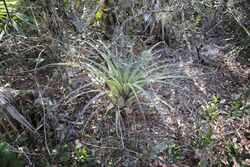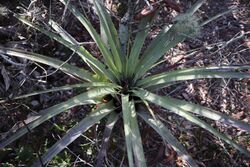Biology:Tillandsia utriculata
| Tillandsia utriculata | |
|---|---|

| |

| |
| T. utriculata tank | |
| Scientific classification | |
| Kingdom: | Plantae |
| Clade: | Tracheophytes |
| Clade: | Angiosperms |
| Clade: | Monocots |
| Clade: | Commelinids |
| Order: | Poales |
| Family: | Bromeliaceae |
| Genus: | Tillandsia |
| Subgenus: | Tillandsia subg. Tillandsia |
| Species: | T. utriculata
|
| Binomial name | |
| Tillandsia utriculata | |
| Synonyms[2] | |
| |
Tillandsia utriculata, commonly known as the spreading airplant, the giant airplant,[3] or wild pine is a species of bromeliad that is native to Florida and Georgia in the United States , the Caribbean, southern and eastern Mexico (Tamaulipas, Veracruz, Oaxaca, the Yucatán Peninsula), Central America, and Venezuela.[2][4][5][6][7][8][9][10][11]
Two varieties are recognized:[2]
- Tillandsia utriculata subsp. pringlei (S.Watson) C.S.Gardner – eastern Mexico
- Tillandsia utriculata subsp. utriculata – most of species range
Florida populations of Tillandsia utriculata are highly susceptible to attack by the invasive weevil Metamasius callizona, and have been devastated throughout their range.[12] Tillandsia utriculata holds more impounded water in its leaf axils, known as its tank, (up to a liter) than does any other Florida bromeliad. It is a major host of many species of aquatic invertebrates. With T. utriculata on a steady decline, a loss of habit is occurring for many of these animal species.[13][14]
References
- ↑ Isley, Paul T. (1987). Tillandsia: The World's Most Unusual Air Plants. Botanical Press. p. 122. ISBN 978-0-9617675-0-1. https://archive.org/details/tillandsiaworlds0000isle/page/122.
- ↑ 2.0 2.1 2.2 Kew World Checklist of Selected Plant Families
- ↑ "Tillandsia utriculata". Natural Resources Conservation Service PLANTS Database. USDA. https://plants.usda.gov/core/profile?symbol=TIUT. Retrieved 9 December 2015.
- ↑ {{citation | mode = cs1 | title = Tillandsia utriculata | work = Germplasm Resources Information Network (GRIN) | url = | publisher = [[Organization:Agricultural Research ServAgricultural Research Service (ARS), United States Department of Agriculture (USDA) | access-date = 2011-11-11 }}
- ↑ Flora of North America, Tillandsia utriculata Linnaeus, Sp. Pl. 1: 286. 1753.
- ↑ Biota of North America Program, 2013 county distribution map
- ↑ Espejo-Serna, Adolfo; López-Ferrari, Ana Rosa; Ramírez-morillo, Ivón; Holst, Bruce K.; Luther, Harry E.; Till, Walter (1 June 2004). "Checklist of Mexican Bromeliaceae with Notes on Species Distribution and Levels of Endemism" (in en). Selbyana 25 (1): 33–86. ISSN 2689-0682. https://journals.flvc.org/selbyana/article/view/121512.
- ↑ Holst, Bruce K. (1 February 1994). "Checklist of Venezuelan Bromeliaceae with Notes on Species Distribution by State and Levels of Endemism" (in en). Selbyana 15 (1): 132–149. ISSN 2689-0682. https://journals.flvc.org/selbyana/article/view/121000.
- ↑ Luther, Harry E. (1995). "An Annotated Checklist of the Bromeliaceae of Costa Rica". Selbyana 16 (2): 230–234. ISSN 0361-185X. https://journals.flvc.org/selbyana/article/view/120747.
- ↑ Acevedo-Rodríguez, P. & Strong, M.T. (2012). Catalogue of seed plants of the West Indies. Smithsonian Contributions to Botany 98: 1-1192.
- ↑ Carnevali, G., J. L. Tapia-Muñoz, R. Duno de Stefano & I. M. Ramírez Morillo. 2010. Flora Ilustrada de la Peninsula Yucatán: Listado Florístico 1–326.
- ↑ Frank, J.H., Cave, R.D. (2005) Metamasius callizona is destroying Florida's native bromeliads [p. 91-101 IN:] Hoddle, M. S. (ed.) Second International Symposium on Biological Control of Arthropods, Davos, Switzerland, September 12–16, 2005. USDA Forest Service FHTET-2005-08. Vol. 1. http://fcbs.org/articles/M_Callizona_Frank_Cave.pdf
- ↑ Frank, J. H., Fish, D. (2008) Potential biodiversity loss in Florida bromeliad phytotelmata due to Metamasius callizona (Coleoptera: Dryophthoridae), an invasive species. Florida Entomologist 91: 1-8 http://journals.fcla.edu/flaent/article/view/75750/73408
- ↑ Cooper, T.M., Frank, J.H., Cave, R.D. (2014) Loss of phytotelmata due to an invasive bromeliad-eating weevil and its potential effects on faunal diversity and biogeochemical cycles. Acta Oecologica 54: 51-56.
External links
Wikidata ☰ Q5243958 entry
 |

